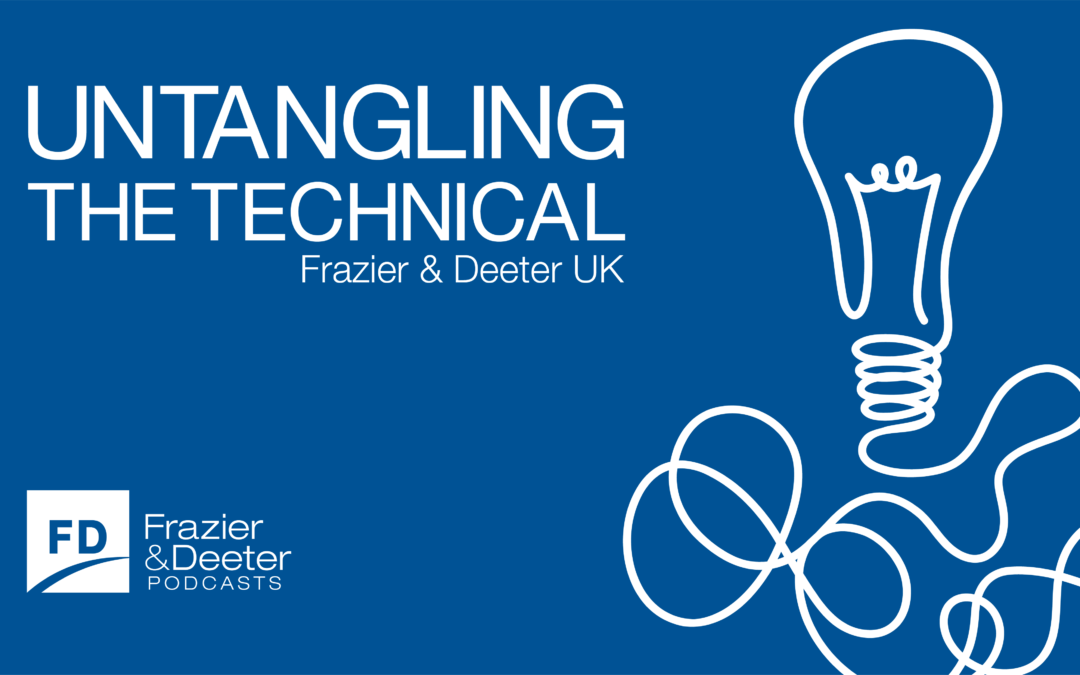The US has passed COVID-19 legislation that may apply to UK business operating in the US. Pete Hine interviews Mike Whitacre, Tax Partner in Frazier & Deeter’s International Practice, to give an update on the COVID-19 legislation.
Recorded April 8th, 2020
Untangling the Technical is available on iTunes and Spotify. Listen now using the player below or download it to listen later. (If you cannot see the player, please accept functionality cookies at the bottom of this page and refresh.)
Untangling the Technical: US COVID-19 Legislation – What UK Businesses Need to Know
This transcript was assembled by hand and may contain some errors.
It has been edited for readability.
Pete Hine Hello, everyone, and welcome to Untangling the Technical UK edition. Untangling the Technical is Frazier & Deeter’s podcast in which we look at complex topics and break them down for business people navigating today’s ever-changing tax and regulatory environment. I’m Pete Hine, the lead audit partner for Frazier & Deeter’s UK practice.
Today, we have Mike Whitacre here with us. Mike is a tax partner in Frazier & Deeter’s international practice, and he is here to give us an update on the new legislation in the US that will have an impact on UK businesses with a US presence. Mike, thanks for joining us.
Mike Whitacre Hi, Pete. I’m happy to be here today.
Pete Today, let’s talk about the various pieces of legislation that have been passed in the U.S. that apply to UK businesses operating in the US. I understand so far there are two new laws passed, could you give us a high-level understanding of the two new laws?
Mike Sure, I’m happy to Pete, but actually there have been three bills passed related to Coronavirus. Everyone tends to overlook the first bill, which, among other things, provided emergency funding for vaccines and ensured that small businesses can qualify for Small Business Administration Economic Injury Disaster Loans. We call those EIDLs.
The second bill, Families First Coronavirus Response Act, or the FFCRA, was designed to get sick people to stay at home or make it easier for people to stay home from work to take care of family members. Then, the CARES Act was developed to try to address economic hardships.
Pete I see, so what do companies with employees in the U.S. need to understand relative to the first legislation.\
Mike The primary intention of this bill was to make it easier for employees to take time off for issues related to the Coronavirus so that people would stay home if necessary. This was accomplished by requiring employers to provide sick leave and family leave specifically for Coronavirus issues. The companies are then allowed credits against their payroll taxes in order to subsidize the costs of this. This is required for companies with under 500 employees.
Pete Okay, so that addressed a fairly urgent need. If we turn our attention to the economic impact the virus is having, what legislation happened thus far? I understand that the CARES Act is quite lengthy. Can you give us the highlights?
Mike The centerpiece of the CARES Act for businesses is what is referred to as “PPP”, or Payroll Protection Program Loans. The primary objective of the PPP loans is to provide funding for companies under 500 employees for eight weeks of their payroll costs in order to retain their employees during the hopefully short-term economic downturn.
Then, the loans will be forgiven tax free if your workforce is not reduced and the proceeds are spent on specified items, such as payroll, mortgage interest, rents and utilities. These loans are funded by the Small Business Administration or the SBA, as we call it, but are actually processed through private banks. If this is of interest, it is important to reach out to an approved SBA lender as soon as possible and if you have an existing banking relationship, you should start with them since they will have familiarity with your business. The banks started accepting applications on Friday, April 3rd, but there have been issues with the various mechanical details and general process issues that are still being worked out, you could still put an application in if you are interested.
Also, if the initial funding is drawn down before you get approved, it’s always possible that another round of funding for these loans may be provided by the government and it would help to already have an application into your bank. In fact, the government is already talking about issuing 250 billion dollars more funding related to the PPP loans. For foreign owned U.S. companies, it is also important to note that the SBA has complex affiliation rules.
This means that for purposes of meeting the SBA’s eligibility requirements, which are generally under 500 employees, they will count employees and all companies under common ownership or control, which will at a minimum include the foreign parent company employees as well as the US entity employees. The affiliation rules may also create issues for businesses with venture capital or private equity shareholders.
If you are able to obtain a PPP loan, it will be important to maintain detailed records about how the funds were used in order to obtain the debt forgiveness later on. Additionally, the SBA also has emergency advances of 10,000 dollars for small businesses. The grants are obtained by applying directly to the SBA for an Emergency Industry Disaster loan, the EIDL. You can still keep the emergency advance even if you do not move ahead with the EIDL loan.
Pete So that applies to companies with fewer than 500 employees, what about those with more than 500 employees in the U.S.?
Mike Yeah, the aid for the companies with more than 500 employees is generally addressed through direct support for specific industries, such as the airlines, or through loan guarantee programs.
Pete I understand there were other tax implications within the law, can you tell us about those?
Mike At a high level, I break the business tax items down into payroll tax provisions and income tax related provisions. The income tax provisions include allowing greater use of net operating losses, or NOL’s as we refer to them, and relaxing the interest deductibility limitations. On the payroll tax provisions, one of the big items is that businesses can defer the payment of the employer portion of their payroll taxes for 2020 50% until December 31, 2021 and 50% until December 31, 2022.
There’s also an employee retention credit. This provision allows for a credit against payroll tax equal to 50% of qualified wages paid to an employee during 2020 if the business was required to suspend operations due to a government order related to COVID-19 or its revenues decreased 50% compared to prior year 2019. Note, that if your business takes a PPP loan that we mentioned earlier, neither of these payroll tax provisions can be used.
Pete You mentioned net operating losses, what are the changes there?
Mike When the new tax laws came into effect back in 2018, NOLs, or net operating losses, were no longer allowed to be carried back and when carried forward, could only offset a max 80% of taxable income. Under the CARES Act, NOLs from 2018, 2019 and 2020 can be carried back five years and losses carried forward to 2019 and 2020 can offset 100% of taxable income rather than just 80%.
Pete Mike, thank you so much for this update. There’s quite a lot of change for our global clients to absorb and it’s been great having someone who can explain what’s going on in the US.
Mike Pete, I’d be delighted to help our listeners in any way that we can with questions about how these provisions impact their businesses. They should reach out to me via email, or using the usual “contact us” link on the Frazier & Deeter website, I’d be happy to help.
Pete That’s great, so your e-mail address is mike.whitacre@frazierdeeter.com, but they can also find that and usual contact details at www.frazierdeeter.com [all one word] and www.frazierdeeter.co.uk.
Mike That’s right.
Pete Thank you, listeners, for joining us for this edition of Untangling the Technical.

